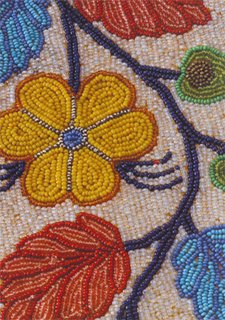 According to oral traditions, the Ojibwe people first lived on the Atlantic coast of North America. About 500 years ago, many of them began migrating west.
According to oral traditions, the Ojibwe people first lived on the Atlantic coast of North America. About 500 years ago, many of them began migrating west.By the mid-1700s, the Ojibwe had established themselves in what is today Central Minnesota. They supported themselves by hunting deer, bear, moose, waterfowl and small game; fishing the area's lakes and streams; gathering wild rice, maple sugar, and berries; and cultivating plants. Their houses were built on pole frames in wigwam shape and were usually covered with birchbark. Birchbark sheets were also used for keeping simple pictographic records of tribal affairs.
Ojibwa mythology was elaborate; the chief religious and superstitious rites centered around the Medewiwin, or grand medicine society. For healing, they relied on medicinal herbs gathered by the women and shamans. They were overwhelmed by new diseases brought by white settlers, which were deadly beyond anything they had seen. The Medewiwin was open to both men and women. Its members performed elaborate healing ceremonies to deal with sickness. Among the Ojibwe, the Medewiwin kept records on birchbark scrolls, an actual written record unique among the Great Lakes tribes. Beyond its healing and religious functions, Medewiwin membership crossed band lines and provided an additional element of political leadership binding the different Ojibwe groups to each other.
As the European settlers headed west, they grew in numbers, and so did their hunger for land. Before long, they began taking more tribal land and natural resources, changing the Ojibwe people's lives forever.
The Ojibwe are still one of the most populous and widely distributed Indian groups in North America, with 150 bands throughout the north-central United States and southern Canada. Ojibwe and Chippewa are renderings of the same Algonquian word, "puckering," probably referring to their characteristic moccasin style. "Chippewa" is more commonly used in the United States and "Ojibway" or "Ojibwe" in Canada, but the Ojibwe people themselves use their native word Anishinabe (plural: Anishinabeg), meaning "original people."
The Ojibwe, Ottawa, and Potawatomi Indians are members of a longstanding alliance called the Council of Three Fires. This alliance was a powerful one that often clashed with the Iroquois and the Sioux, eventually getting the better of both. The Ojibwe people were not as negatively affected by European epidemics as their densely-populated Algonquian cousins to the east, and they resisted manhandling by the whites much better. Very few Americans realize that the Ojibwe were a major power. Their location was well north of the main flow of settlement, and their victories over native enemies have never received proper credit.
Most of their lands were appropriated by the Americans and Canadians, a fate shared by all native peoples of North America, but plans to export the Ojibwe to Kansas and Oklahoma never succeeded, and today nearly all Ojibwe reservations are still within their original territory.
Each Ojibway band (tribe) has its own government, laws, police, and other services, just like a small country. The political leader of a band is called "gimaa" or "ogimaa" in the Ojibwe language, usually translated as "chief" in English ("chef" in French). The ogimaa used to be a male chosen by tribal council members, often from among the previous chief's sons, nephews, or sons-in-law, but today ogimaas can be of either gender and are popularly elected in most Ojibwe bands, just as mayors and governors are.
In 1990, 103,826 people in the United States claimed Ojibwa ancestry; most lived on reservations in Michigan, Minnesota, Wisconsin, North Dakota, and Montana.
Essiac is said to have come from an Ojibwe medicine man, but no one can really prove or disprove this theory.
There are many prominent Americans with Ojibwe ancestry.
Here are some fascinating Ojibwe links:
Culture of an Indian Nation
Native Tech: Ojibwe
The Ojibwe Learner Page
One of my favorite authors ever: Louise Erdrich
Ojibwe History
Wild Rice
White Earth Land Recovery Project


No comments:
Post a Comment